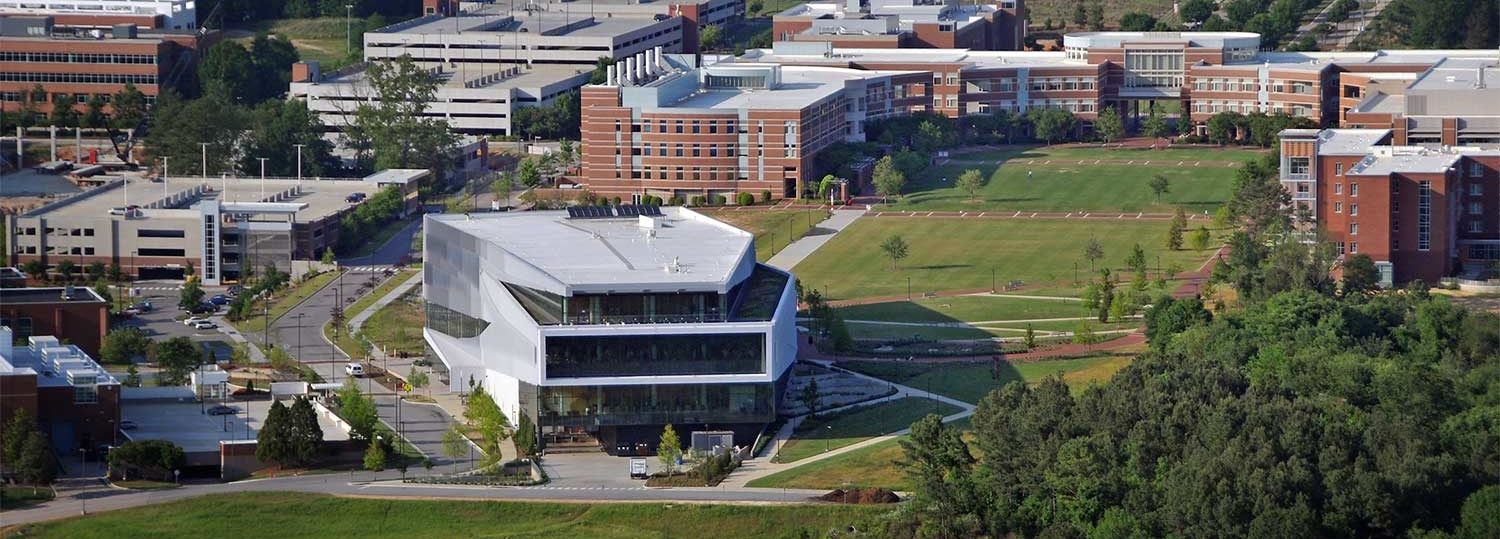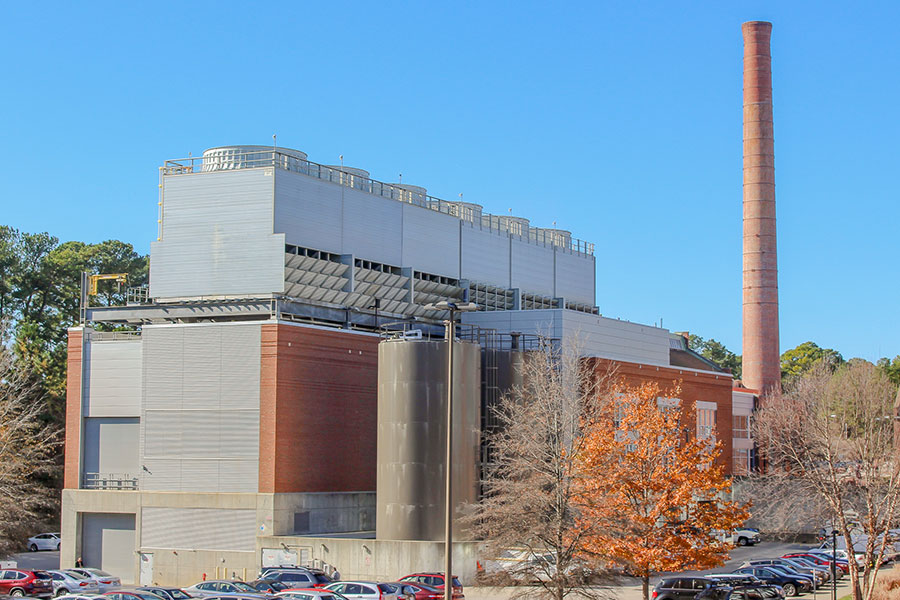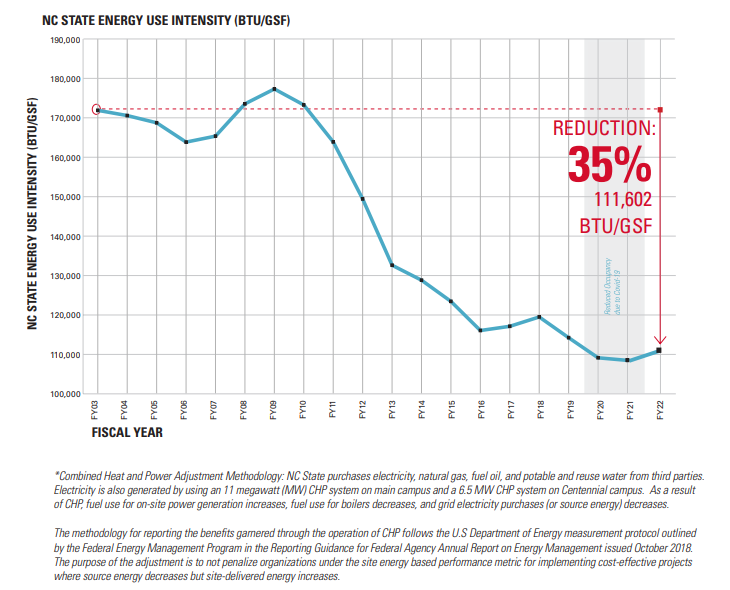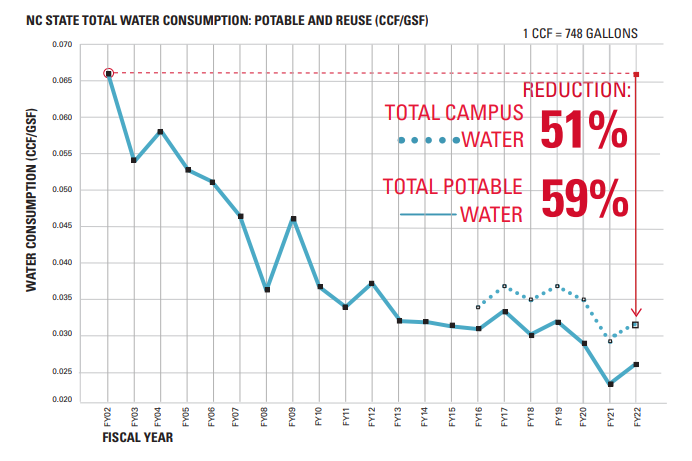
Progress
Energy and water are among NC State’s most necessary and costly expenses. For more than a decade, the university’s campus-wide energy management strategies have enabled significant conservation of vital fiscal and environmental resources.
Annual Energy and Water Report
The Energy and Water Report for Fiscal Year 2022 provides an update on campus progress toward utility reductions, highlights specific projects and outlines strategies for the next fiscal year that will contribute to further reductions.

Browse the 2022 Energy and Water Annual Report
July 1, 2021 – June 30, 2022
Energy Consumption
Campus energy consumption peaked in fiscal year 2009 and has trended downward since. Reduced occupancy on campus during the pandemic produced a greater energy reduction in 2020 and 2021 than would have otherwise been achieved. Energy-intensive Covid-19 mitigation strategies such as higher air filtration, increased outdoor air levels and longer hours of HVAC operation to allow flushing of air before and after building occupancy for safety increased energy usage in 2021-2022. Compared to the FY 2003 baseline, total energy consumption per gross square foot (GSF) has decreased by 35% in FY 2022.

Water Consumption
In fiscal year 2016, NC State began utilizing non-potable reuse water supplied by the City of Raleigh on Centennial Campus. Reuse water is wastewater treated to a high standard and reused instead of being discharged into a waterway. Reuse water provides a more cost-effective and drought resistant supply of water for cooling towers, irrigation and toilet flushing. For total water consumption (potable and reuse), FY 2022 marked a level 51% below the FY 2002 baseline with potable water consumption decreased by 59%.

The following are highlights and accomplishments of energy efficiency strategies implemented on campus during fiscal year 2022:
REINVESTMENT SAVINGS
Through collaboration among business units within the Facilities Division, Energy Management compiled the fiscal year (FY) 2022 Reinvestment Act claim for more than $3 million in energy savings. The Reinvestment Act of 2010, also known as NC House Bill 1292, allows NC institutions to capture a portion of energy and water savings for reinvestment in further conservation projects.
Campus Energy Projects
NC State successfully funded more than $1,515,000 of campus energy projects that resulted in projected annual savings exceeding $960,000. Multiple projects ranging from whole building lighting upgrades to building controls upgrades were completed through cost-sharing programs with campus partners.
Commissioning
The in-house Commissioning Team’s work continues to improve the efficiency of NC State buildings through mechanical equipment calibrations, sequence adjustments and HVAC schedule implementations. Partnering with Building Maintenance and Operations technicians, the team achieved $2.5 million in savings in fiscal year (FY) 2022.
PERFORMANCE CONTRACTS
NC State’s Energy Performance Contracts span 3 utility plants and 14 buildings across campus. Upgrades range from Combined Heat and Power (“Cogeneration”) to HVAC systems upgrades. Each project has a guaranteed annual energy savings; when combined, these projects help NC State avoid at least $10.5 million in utility costs per year.
LED LIGHTING
Funding has been identified for the second phase of the Exterior Lighting LED Conversion project that converts existing pole-mounted lights to LED. This project increases energy efficiency and also enhances nighttime safety. The first phase converted nearly 1,200 existing pole-mounted lights to LED, while also installing over 150 new pole-mounted lights. With the first phase completed, NC State’s pole-mounted exterior lighting is over 50% LED, and the overall project aims to save over $100,000 annually in electricity costs with the more efficient LED lights. The second phase will continue these efforts by targeting over 300 lights on South Campus along with over 1,100 lights on Centennial Campus.
holiday energy savings initiative
Campus Operations & Maintenance takes advantage of the university’s multi-day winter holiday closure by incorporating a Holiday Energy Savings Initiative (HESI). Through this initiative, building temperature setpoints are lowered, unnecessary lights and equipment are turned off and doors and windows are closed throughout campus in an effort to reduce utility consumption. During the FY 2022 HESI, $416,000 in energy costs were avoided, and since inception in 2005, the HESI program has accounted for over $5,200,000 in energy cost avoidance.